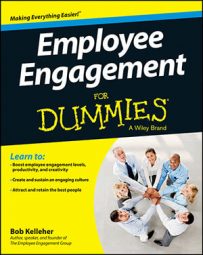Saying communication is “important to engagement” is a little like saying Mardi Gras is “kind of exciting.” Indeed, communication is so important to employee engagement, it’s often called the cornerstone of an engaged culture. There's no doubt about it: Communication helps drive most successful new company initiatives, ideas, and ventures. Unfortunately, it's also at the root of many organizational failures, boss–employee issues, and problems with disengagement.
Focus on the importance of communication both generally and in your employee engagement efforts, and tackle the obstacles to achieving excellent communication. You can learn some simple, practical methods for cascading the company message from upper management down through the ranks in ways that are clear, concise, and compelling — and that will result in higher engagement, and therefore higher discretionary effort, on the part of staff.
Employee / management disconnect
In many organizations, there is a disconnect between leaders and employees. This fissure is at the root of many communication problems in organizations today. For management, the disconnect centers around the question “Why aren't employees onboard?” For employees, the question is, “What are those idiots doing now?” This disconnect is often a key factor in disengagement.
As an example, while at the start of a 5K running race, those slated to start near the tail end of the field of 12,000 runners might never hear the starting gun; they are too far back. They might only learn the racers are off and running by rumor. Whereas the runners at the front of the pack hit the ground running (so to speak), those in the back merely shuffled forward.
It is a lot like how information is communicated in some organizations. The CEO and other executives hear the starting gun — or, in many cases, are the ones firing it. Just like the elite runners at the front of the pack, leadership is at the front of the communication pipeline. When an important change is communicated, leadership has time to weigh alternatives, debate options, and digest the decision.
The rank and file employees, relegated to the back of the field, are not afforded the same depth of background, and may be unaware of how much time leadership has invested in the decision. When communication about a decision or change finally reaches them, employees inevitably wonder, “What are they thinking?!” They don't hit the ground running; they merely shuffle forward. Then, when employees are hesitant to jump onboard, leaders lose patience. They ask, “Why don't they get it?!”
Do your employees understand the company goals and strategy?
Unfortunately, this communication pattern results in a lack of alignment. After all, if a company neglects to articulate a clear vision, it can hardly expect its employees to invest more than the bare minimum. In one oft-quoted study, conducted by Robert S. Kaplan and David P. Norton in 2001, a mere 7 percent of employees reported that they fully understood their company's business strategies and what was expected of them in order to help achieve the company's goals.
Companies that successfully engage their employees don't allow this to happen. Employers or leaders who articulate a clear vision and strategy will find that employees will help them reach their goals quickly and efficiently.
Indeed, according to recent research by Dale Carnegie Training, employees indicated that working in a company that encourages open communication with senior leadership has a significant impact on their level of engagement. To cultivate an engaged culture, open and consistent communication must become part of the air your employees breathe.

